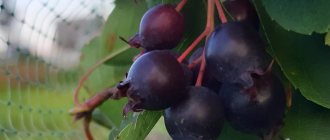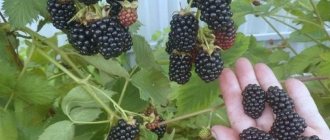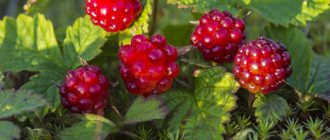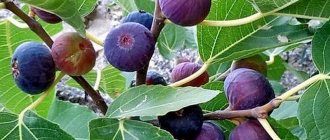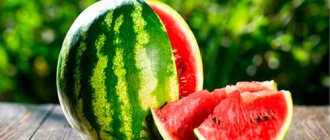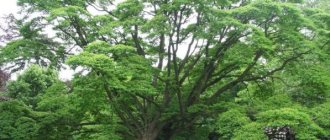Physalis edible and decorative (video)
Physalis pineapple (pineapple)
This unique botanical variety differs from the “classic” strawberry variety by its miniature fruits. The variety is early ripening, forming a harvest in the last ten days of June, approximately 3.4 months after emergence. Unripe fruits are pale green in color, and at the stage of full ripening they acquire a yellowish-cream color. The pulp has a sweet taste and also has a rich aroma. They are used fresh, as well as for making raisins and candied fruits, and making jam.
The culture is heat-loving, so cultivation in the central zone of our country is carried out by seedlings. The optimal temperature regime is 20-22°C before emergence, and within 15-20°C at the stage of plant growth and development. Seedling material is planted in flower beds and open ground ridges only after the likelihood of a return of late spring frosts has completely passed. The planting site should be represented by sufficiently fertile, loose and well-drained soils. Planting in accordance with the 40x30 cm pattern.
Physalis pineapple (pineapple)
Physalis wren
An early ripening variety related to vegetable crops. The harvest is used for processing into vegetable caviar, for making preserves and marmalade, making candied fruits and dry wine, and is also pickled and pickled. The ripe fruits are tasty and juicy, round in shape and yellow in color and have increased gelling properties. The plant is not a standard determinant type, with an erect aerial part and average branching rates, with a height of 0.6-0.8 m.
We also recommend reading:
16 most popular indoor plants Spruce in landscape design: the best decorative varieties and growing features Kalanchoe: description of types and features of care at home Hyacinth flower: description of types, features of planting and care in indoor conditions
Beneficial properties of pineapple physalis
Physalis is a member of the nightshade family, native to South and Central America. The shoots are erect, from 50 to 100 cm high. The leaves are thin, opposite, ovoid, with jagged edges. The flowers are solitary, cream or white in color. The calyx is bell-shaped, the petals have a pointed tip. The fruits are round, yellow-orange, weighing 5-10 g. The pulp is sweet, with a pronounced aroma.
Physalis berries have medicinal properties:
- have diuretic and choleretic effects;
- stop bleeding;
- relieve pain;
- destroy bacteria.
Pineapple physalis is useful for rheumatism, gout, colds, stomach ulcers, gastritis, diabetes, hypertension. The plant removes heavy metals, cholesterol, toxins and breakdown products.
Fresh berries restore the functioning of the endocrine and digestive systems, lower blood pressure, and relieve inflammation. Due to their low calorie content (53 kcal per 100 g), fruits are included in the diet.
It is not recommended to consume pineapple physalis fruits if you have high stomach acidity. Another contraindication is individual intolerance to berries.
Gallery: physalis (50 photos)
Decorative varieties of physalis
Almost all varieties of physalis are characterized by a very attractive, decorative appearance. For the purpose of decorative decoration of the local area, physalis "Alkekengi" or common physalis (Physalis alkekengi), as well as physalis "Franche" (Physalis francheti) and Makino (Physalis franchetii Mast) are planted. Such varieties are very unpretentious, can easily tolerate cold, and can grow in almost any type of soil.
Physalis vulgaris
A herbaceous perennial 45-65 cm high with white, five-lobed flowers and a reddened calyx that grows after flowering in the form of a swollen, relatively large bubble.
"Franche"
Japanese highly decorative variety with oval, aesthetic foliage expanded at the base. Chinese lanterns are an annual or perennial crop just under a meter tall, with leaves that are oval and widened at the base and have brightly colored calyxes.
What does physalis look like?
You may not know the name of this plant, but its famous red boxes are familiar to everyone. It’s not for nothing that physalis is nicknamed Chinese lanterns: its thin and almost transparent red shell resembles a paper product launched into the sky. As for the description of physalis in book language, it is classified as a nightshade and is called a distant relative of the tomato.
However, we must not forget that among the varieties there are edible and decorative forms:
- the decorative one is not suitable for food, these are the same dried winter bouquets of bright red color;
- there is a vegetable type of physalis, of Mexican origin (it is most similar to cherry tomatoes, therefore it is often called the Mexican tomato);
- berry varieties have South American roots; the fruits inside the lantern are much smaller and look like large currants or gooseberries.
Where does physalis grow?
Everything new in our gardens is something old that is once again experiencing popularity and has long been forgotten. Physalis arrived in our latitudes at approximately the same time as tomatoes. However, his path was much shorter; for a long time, red lanterns were only occasionally used for compositions of dried flowers. Since physalis grows well in our latitudes, berry and vegetable species have become popular.
It is difficult to call physalis a ubiquitous plant; its cultivation is rather exotic. The bravest ones make jam from berry varieties, which tastes like caramel. In its homeland, Central and South America, it is simply a weed. In the wild, the plant reproduces successfully without human help. After the emergence of productive varieties, the fruits began to be grown in mountainous areas as berries.
Technology for growing physalis from seeds
The peculiarities of climatic conditions in our country make it possible to grow ornamental or vegetable crops exclusively by sowing seeds in order to obtain seedlings. Seedlings are transplanted into open ground at the age of one and a half months, after the risk of return frosts has passed. When making your own planting substrate, you need to mix a couple of parts of peat, one part of compost and one part of garden soil, as well as half a part of medium-grained sand. If necessary, dolomite flour or traditional wood ash is added.
Planting technology:
- seed material is disinfected within a quarter of an hour in a manganese solution or in a solution of the growth stimulator “Epin”;
- planting containers are filled with prepared and disinfected nutrient soil substrate;
- the prepared seeds are sown at the same distance from each other and sprinkled with a centimeter layer of nutritious soil substrate with slight compaction;
- at the final stage, it is necessary to perform thorough and careful watering, after which the crops are covered with plastic film, and the seedling container is installed in a place well lit by the sun. The covering film is removed from the crops only after the emergence of mass shoots.
Growing seedlings should be watered regularly, avoiding waterlogging and drying out of the soil. After two or three true leaves have formed on the sprouts, the seedling material is picked. The composition of the soil for diving should be similar to the seeding nutrient substrate, with a limitation on the amount of sand. It is also necessary to add complex mineral fertilizer to the planting container. To feed the picked seedlings, Fertika, Agricola or Mortar are used a couple of times a month.
Planting physalis in the garden
In the last ten days of April, after sufficiently warm weather has established itself, growing ornamental or vegetable seedlings are hardened off in the daytime in the fresh air. Around the middle of the last spring month, plants can be planted under film covers. The age of the planted seedlings should be approximately one and a half months. Elongated plants are planted at a slight angle. The top layer of soil should not be very waterlogged.
The area allocated for planting vegetable or ornamental physalis must be selected correctly in advance. It is extremely undesirable to grow a crop after plants represented by peppers, potatoes, tomatoes or eggplants. When digging up an area allocated for planting, a sufficient amount of fertilizer should be added. It is recommended to apply approximately 45 g of nitroammophoska for each square meter of soil. Excess soil acidity must be corrected. For this purpose, it is necessary to add about 250 g of ordinary wood ash per square meter.
For planting seedlings, planting holes are dug, located at a distance of half a meter from each other. The standard distance between rows should be 65-70 cm. When planting seedlings in a permanent place, you should try not to injure the root system of the plant, and also preserve the earthen ball as much as possible. The seedlings of the crop are buried down to the first leaf. Planted plants need to be watered and mulched with peat chips.
Approximately in the middle of the last spring month, fesalis can be planted under film covers
What to cook from pineapple physalis for the winter
Jams, jams and compotes are prepared from pineapple physalis. If you dry the berries, you can use them as a dessert.
Ingredients for making jam:
- ripe fruits – 600 g;
- granulated sugar – 800 g;
- cinnamon – 2 pcs.
Recipe for winter jam from Physalis pineapple:
- The berries are peeled, washed and the skin is pierced with a needle.
- Pour the mixture into a saucepan, add sugar and leave for half an hour.
- Then add a glass of water and place the container on low heat.
- The mixture is stirred until the sugar is completely dissolved and 4 cinnamon sticks are added.
- Boil the jam for 5 minutes, then turn down the heat and keep on the stove for 2 hours.
- The finished product is placed in jars.
Read also: Tomato - Koenigsberg: reviews, photos, variety yield
To prepare jam, the following set of products is required:
- ripe berries – 1 kg;
- sugar – 1 kg;
- water – 1 glass.
Simple jam recipe:
- The fruits are peeled, washed and dried on a towel.
- Physalis is poured into a saucepan, water is added and put on fire.
- The mixture is boiled for 20 minutes until the berries are completely softened.
- When the pulp is boiled, add sugar.
- Keep the jam on low heat for another 25 minutes until you get a homogeneous consistency.
- The finished jam is placed in sterilized jars for the winter.
Candied fruits are fruits boiled in sweet syrup. This dessert can be obtained from physalis. The process is quite simple, but takes a lot of time.
Recipe for candied fruits:
- The berries are removed from the boxes, washed and poured boiling water for 2 minutes. This will remove the top layer containing a sticky substance with an unpleasant odor.
- The fruits are washed with cold water, then pierced with a needle.
- A syrup consisting of water and sugar is placed on the stove to boil. The liquid is boiled, then the heat is turned down and the granulated sugar is allowed to dissolve.
- The berries are dipped in hot syrup and boiled for 5 minutes. Then the stove is turned off and the mass is left for 8 hours at room conditions.
- The process is repeated 5 more times.
- When the last cooking is complete, transfer the berries to a colander and wait for the syrup to drain.
- The fruits are laid out on sheets of parchment and dried for 5-7 days.
- Candied fruits are sprinkled with powdered sugar and stored in a cool, dark place.
To get a delicious drink you will need:
- Physalis pineapple fruits – 800 g;
- sugar – 400 g.
Algorithm for preparing compote from Physalis pineapple:
- Ripe fruits are peeled and washed under running water.
- The resulting mass is transferred to a saucepan and scalded with boiling water.
- The berries are cooled in cold water.
- Place the container on the fire and add sugar.
- The fruits are boiled until they soften.
- The finished compote is poured into sterilized jars and covered with lids for the winter.
To prepare Physalis raisins, take the required number of berries. Dried fruits are added to muesli, salads and yoghurts. They can be used as a seasoning for soups and main courses.
The procedure for obtaining raisins from Physalis pineapple:
- The berries are cleaned and blanched with boiling water. Then the thin transparent peel is removed from them.
- The fruits are laid out on a baking sheet in one layer.
- Turn on the oven at 60°C and set the berries to dry.
- Store finished raisins in a cool, dark place.
If weather conditions permit, pineapple physalis berries are left outside in direct sunlight. A convenient way to obtain raisins is to use electric dryers.
Secrets of proper care for physalis
Despite its unpretentiousness, you need to care for the plant very competently:
- soil cultivation should be regular, especially after irrigation measures, which is due to the need to ensure an intense flow of oxygen to the root system;
- the soil on the site should not be overly moist, with stagnant water, or too dry;
- weeding activities should be systematic, followed by loosening, but mulching the soil is optimal;
- In the process of irrigation activities, it is very important to fertilize garden crops with organic matter in the form of a solution based on chicken manure with the addition of wood ash, or mullein.




